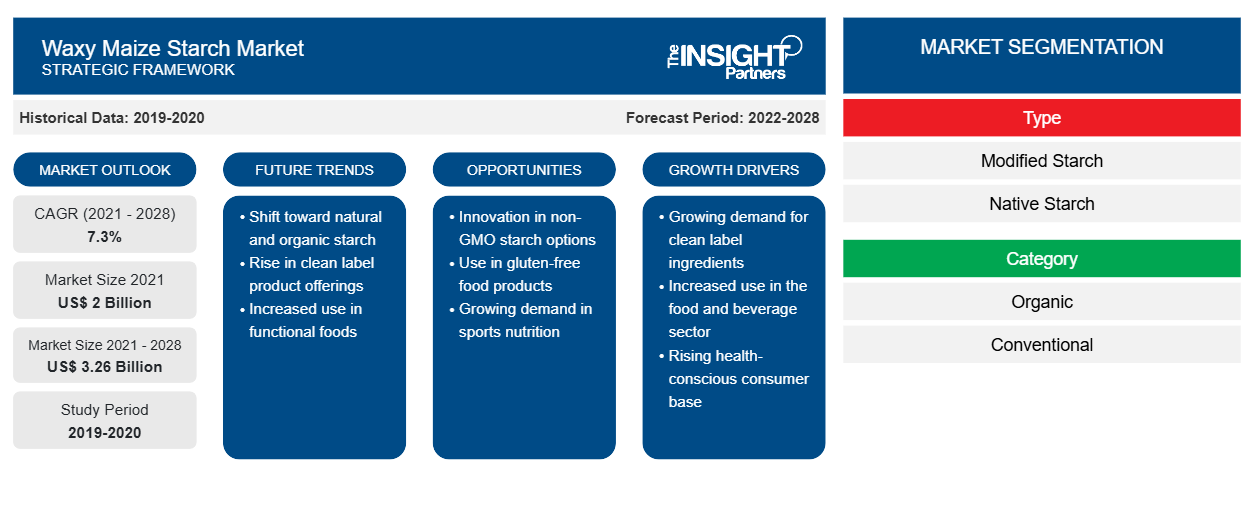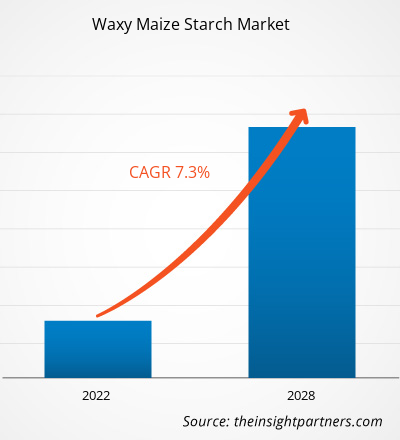The waxy maize starch market is valued US$ 2,000.68 million in 2021; It is expected to grow at a CAGR of 7.3% from 2022 to 2028.
Waxy maize starch is a complex carbohydrate derived from maize or corn. It is used as an additive in various end-use industries, such as food, textiles, and pharmaceuticals. It is added to individual yarns to increase the mechanical strength and resistance to friction and also resist moisture penetration. It also serves as a stabilizer and filler for colored inks when fabrics are overprinted. Consumption of waxy corn starch has been rising significantly in the food industry, as it is used as a thickening agent in soups & gravies, pie fillings, stews & casseroles, and sauces due to its high water absorption capacity. The waxy maize starch market is likely to grow significantly in the near future due to its functional properties, such as foaming and gelling, which make it a vital additive for various end-use industries.
Asia Pacific held the largest waxy maize starch market share in 2021, while other developing regions, such as the Middle East & Africa, are expected to grow significantly in the forecast period. The market is proliferating owing to the potential customer base of developing economies such as China and India, people's food preferences, and the rising demand for healthy, functional food products. Waxy maize starch is extensively utilized in food & beverages and textile & paper manufacturing sectors to stabilize and emulsify products and as a powder binder in the pharmaceutical industry. According to China Starch Industry Association, 39.17 million tons of corn starch were produced in China in 2021. All these factors are anticipated to boost the waxy maize starch market growth during the forecast period.
Customize This Report To Suit Your Requirement
You will get customization on any report - free of charge - including parts of this report, or country-level analysis, Excel Data pack, as well as avail great offers and discounts for start-ups & universities
Waxy Maize Starch Market: Strategic Insights

-
Get Top Key Market Trends of this report.This FREE sample will include data analysis, ranging from market trends to estimates and forecasts.
Impact of COVID-19 Pandemic on Waxy Maize Starch Market
The COVID-19 pandemic brought unprecedented challenges for many sectors in early 2020. Lockdowns, border restrictions, travel bans, manufacturing discontinuation, and other safety measures rolled out by governments as per the guidelines of the WHO and national health ministries hampered manufacturing operations. However, In 2021, various economies and industries resumed operations as several governments of different countries announced the relaxation of the previously imposed restrictions. Manufacturers were permitted to operate at full capacity, which helped them overcome the demand and supply gaps and other repercussions. Further, the waxy maize starch manufacturers are focusing on increasing their production to revive their businesses by the end of 2022.
Market Insights
Increasing Strategic Developments by Major Market Players
The manufacturers of waxy maize starch are making strategic developments, such as product innovation, plant capacity expansion, and mergers & acquisitions, to strengthen their market position and expand their customer base. For instance, in September 2021, AGRANA Beteiligungs-AG, one of the prominent manufacturers of starches and other food ingredients, invested US$ 24.87 million in expanding its specialty starch manufacturing plant across Austria. The specialty starch to be processed in the Austrian plant includes waxy maize starch and organic maize starch. With the plant capacity expansion, the company expects to meet the rising demand for specialty starches across Austria and other European markets. Therefore, continued strategic developments by market players are expected to provide immense opportunities to the waxy maize starch market during the forecast period.
Type-Based Insights
Based on type, the waxy maize starch market is segmented into modified starch and native starch. The native starch segment is projected to acquire a larger market share during the forecast period. Native starch is widely used as a texturizer, gelling, stabilizing, and thickening agent by food and beverage manufacturers. It can be added to a wide range of food products, including bakery items, soups and sauces, processed meat products, snacks, alcoholic and nonalcoholic beverages, and dry blends. Moreover, it is used as a universal thickener for paints and various coatings. In the production of label adhesives, native waxy starch shows an increased adhesive ability when working on high-speed machines. Cargill Incorporated, Roquette Frères, and Tate and Lyle are the leading waxy maize starch manufacturers.
Category-Based Insights
Based on category, the waxy maize starch market is segmented into organic and conventional. The organic segment is projected to register a higher CAGR in the market during the forecast period. It is of superior quality compared to inorganic maize. Therefore, the demand for organic maize starch is projected to increase rapidly in the coming years as customers demand premium quality and natural products. In the food industry, organic waxy maize starch is frequently used as a thickener. For example, it is used as an emulsifier in salad dressing, ready meals, soups, and infant food. Additionally, vegan products are made with GMO-free organic starch.
Application-Based Insights
Based on application, the waxy maize starch market is segmented into food & beverages, dietary supplements, pharmaceuticals & nutraceuticals, and others. The pharmaceuticals & nutraceuticals segment is projected to register the highest CAGR in the market during the forecast period. The maize starch and its derivatives are also used in topical formulations, such as ointments and lotions. It is used in various dosage forms, including swallowable tablets, hard capsules, blends, granules, and pellets premix. The paste of maize starch with a concentration of 5–20% is frequently employed in tablet manufacturing to enhance the binding capacity of the formulation.
Key players operating in the waxy maize starch market are Cargill, Incorporated; Tate & Lyle PLC; AGRANA Beteiligungs-AG; Manildra Group; Roquette Frères; Sinofi Ingredients; Tokai Denpun Co., Ltd.; Sanwa Starch Co., Ltd.; New Zealand Starch Limited; and SAMYANG CORPORATION. These players are engaged in developing products with reduced health risks to meet emerging consumer trends and abide by regulatory frameworks. They are involved in mergers and acquisitions, business expansions, and partnerships to expand their market share.
Waxy Maize Starch Market Regional InsightsThe regional trends and factors influencing the Waxy Maize Starch Market throughout the forecast period have been thoroughly explained by the analysts at The Insight Partners. This section also discusses Waxy Maize Starch Market segments and geography across North America, Europe, Asia Pacific, Middle East and Africa, and South and Central America.
Waxy Maize Starch Market Report Scope
| Report Attribute | Details |
|---|---|
| Market size in 2021 | US$ 2 Billion |
| Market Size by 2028 | US$ 3.26 Billion |
| Global CAGR (2021 - 2028) | 7.3% |
| Historical Data | 2019-2020 |
| Forecast period | 2022-2028 |
| Segments Covered |
By Type
|
| Regions and Countries Covered |
North America
|
| Market leaders and key company profiles |
|
Waxy Maize Starch Market Players Density: Understanding Its Impact on Business Dynamics
The Waxy Maize Starch Market is growing rapidly, driven by increasing end-user demand due to factors such as evolving consumer preferences, technological advancements, and greater awareness of the product's benefits. As demand rises, businesses are expanding their offerings, innovating to meet consumer needs, and capitalizing on emerging trends, which further fuels market growth.

- Get the Waxy Maize Starch Market top key players overview
Report Spotlights
- Progressive industry trends in the waxy maize starch market to help players develop effective long-term strategies
- Business growth strategies adopted to secure growth in developed and developing markets
- Quantitative analysis of the waxy maize starch market from 2022 to 2028
- Estimation of global demand for waxy maize starch
- Porter's Five Forces analysis to illustrate the efficacy of buyers and suppliers operating in the industry
- Recent developments to understand the competitive market scenario
- Market trends and outlook and factors governing the growth of the waxy maize starch market
- Assistance in the decision-making process by highlighting market strategies that underpin commercial interest, leading to the market growth
- Size of the waxy maize starch market at various nodes
- Detailed overview and segmentation of the market and the waxy maize starch industry dynamics
- Size of the growth in various regions with promising growth opportunities
Frequently Asked Questions
Based on the application, which is the fastest-growing segment in the waxy maize starch market?
What are the key drivers for the growth of the global waxy maize starch market?
What is the largest region of the global waxy maize starch market?
Based on the type, why does the native starch segment have the largest revenue share?
What are the opportunities for waxy maize starch in the global market?
Can you list some of the major players operating in the global waxy maize starch market?
- Historical Analysis (2 Years), Base Year, Forecast (7 Years) with CAGR
- PEST and SWOT Analysis
- Market Size Value / Volume - Global, Regional, Country
- Industry and Competitive Landscape
- Excel Dataset
Recent Reports
Testimonials
Reason to Buy
- Informed Decision-Making
- Understanding Market Dynamics
- Competitive Analysis
- Identifying Emerging Markets
- Customer Insights
- Market Forecasts
- Risk Mitigation
- Boosting Operational Efficiency
- Strategic Planning
- Investment Justification
- Tracking Industry Innovations
- Aligning with Regulatory Trends





















 Get Free Sample For
Get Free Sample For